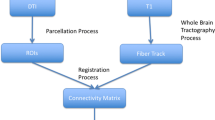Abstract
We represent neural networks by directed graphs and consider the problem of maximal connectivity with constraints. This problem is motivated by some conflicting objectives in the design of biological neural networks. Inequalities and equations derived are tested on data and numerical estimates for parameters of a human brain. Results support an intuition that human brain is maximally connected subject to constraints on in- and out-degrees.
Mathematics Subject Classification (2010): Primary 94C15; Secondary 92C20
Access this chapter
Tax calculation will be finalised at checkout
Purchases are for personal use only
Similar content being viewed by others
References
M.F. Bear, B.W. Connors, M. Paradiso, Neuroscience: Exploring the Brain, 3rd edn. (Lippincott Williams & Wilkins, PA, 2007)
R.V. Belavkin, Do Neural Models Scale Up to a Human Brain? International Joint Conference on Neural Networks (IJCNN 2007) (IEEE, NY, 2007)
E. Bullmore, O. Sporns, Complex brain networks: Graph theoretical analysis of structural and functional systems. Nat. Rev. Neurosci. 10, 186–198 (2009)
R. Poritsky, Neuroanatomy: A Functional Atlas of Parts and Pathways (Hanley & Belfus Inc., PA, 1992)
C.E. Shannon, A mathematical theory of communication. Bell Syst. Tech. J. 27, 379–423, 623–656 (1948)
R.L. Stratonovich, Information Theory (Sovetskoe Radio, Moscow, 1975), In Russian
Acknowledgements
This work was supported in part by EPSRC grant EP/DO59720.
Author information
Authors and Affiliations
Corresponding author
Editor information
Editors and Affiliations
Rights and permissions
Copyright information
© 2013 Springer Science+Business Media New York
About this chapter
Cite this chapter
Belavkin, R.V. (2013). Maximal Connectivity and Constraints in the Human Brain. In: Pardalos, P., Coleman, T., Xanthopoulos, P. (eds) Optimization and Data Analysis in Biomedical Informatics. Fields Institute Communications, vol 63. Springer, New York, NY. https://doi.org/10.1007/978-1-4614-4133-5_10
Download citation
DOI: https://doi.org/10.1007/978-1-4614-4133-5_10
Published:
Publisher Name: Springer, New York, NY
Print ISBN: 978-1-4614-4132-8
Online ISBN: 978-1-4614-4133-5
eBook Packages: Mathematics and StatisticsMathematics and Statistics (R0)




